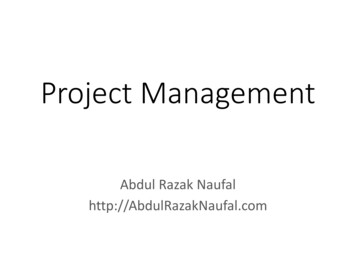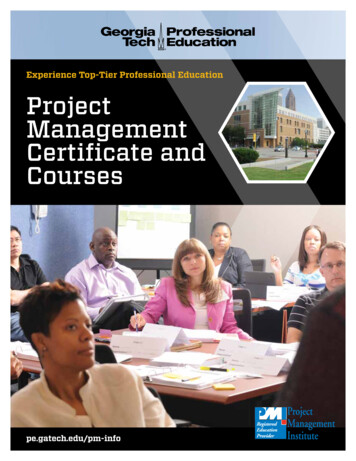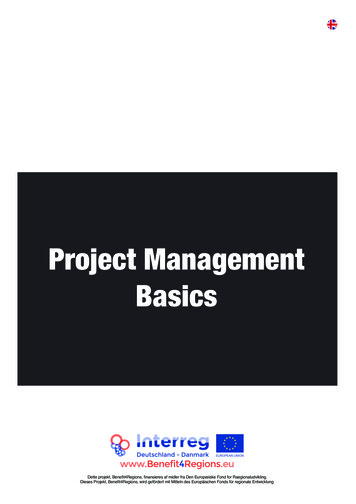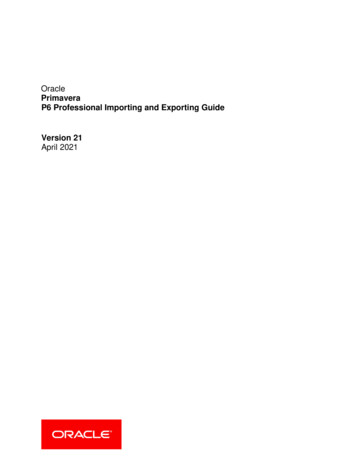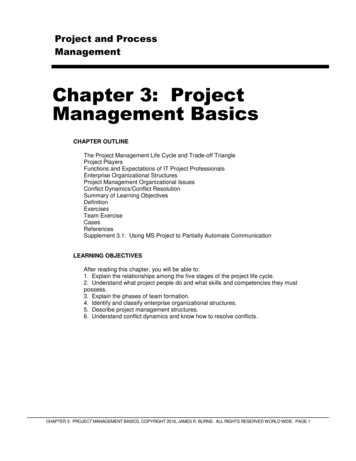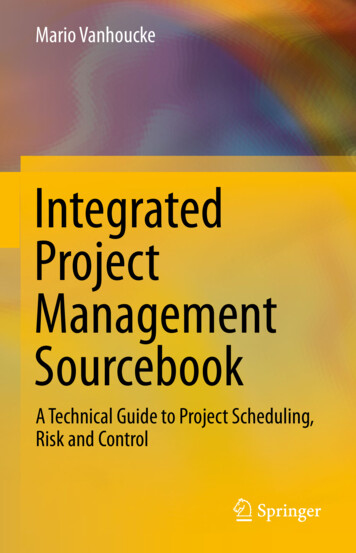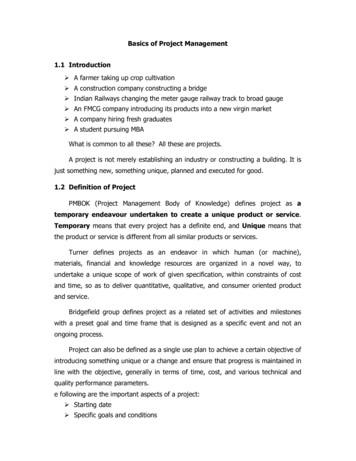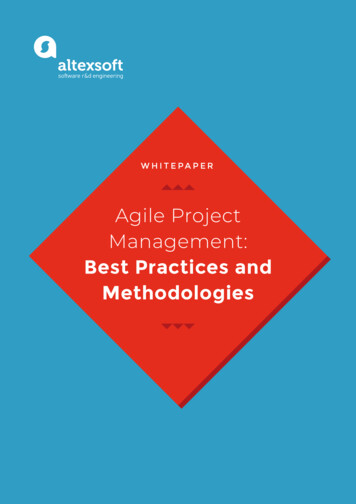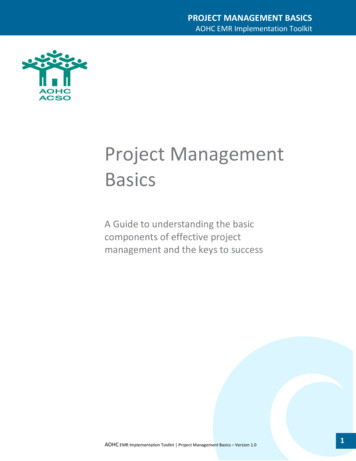
Transcription
PROJECT MANAGEMENT BASICSAOHC EMR Implementation ToolkitsProject ManagementBasicsA Guide to understanding the basiccomponents of effective projectmanagement and the keys to successAOHC EMR Implementation Toolkit Project Management Basics – Version 1.01
PROJECT MANAGEMENT BASICSAOHC EMR Implementation ToolkitsContents1.0 Who should read this Guide . 31.1 Overview . 31.2 Project Management Basics. 41.3 Lessons Learned . 101.4 The Work Plan . 11Sources for this guide include eHealth Ontario's Guide to ProjectManagement v 1.1, and the OPS People and Organizational ChangeFramework v 2For questions or comments, please contact:AOHC EMR ProjectAssociation of Ontario Health Centresemr@aohc.orgAOHC EMR Implementation Toolkit Project Management Basics – Version 1.02
PROJECT MANAGEMENT BASICSAOHC EMR Implementation Toolkits1.0 Who should read this GuideFor those who may be formally managing a project for the first time, thisguide aims to help you understand the basic components that areimportant to your project success. For those who have been involved inproject management before, you might find this guide useful as areminder of the basic principles or as a tool that you can provide to otherproject team members to ensure everyone has the same understandingof the project, project management in general, and the keys to success.1.1 OverviewWhether you are buying a new car, renovating a room in your house, orfinally getting around to taking that ‘once in a lifetime vacation,’ thereare certain activities you will undertake to ensure your venture is assuccessful as possible. You will know what you’re starting with, andyou’ll have a pretty good idea of where you want to go or what you wantthe end result to be. You’ll create plans, and you’ll anticipate potentialpitfalls or problems. You will decide who you need to help you, and howmuch you want to spend. In short, you will be managing a project. Eachnew set of activities, solution or program that you integrate into yourorganization can also be considered a project.A project may involve only one person (e.g. a solo-practice physician), orthousands (e.g. all hospital employees). It may last several days, or manyyears. It may be undertaken by a single organization (e.g. a family healthteam), or by an alliance of several stakeholders (e.g. AOHC, CommunityHealth Centres, eHealth Ontario).Regardless of the size or complexity of the project, the experts agree onthe following: A Project is defined as any work that happens only once, has aclear beginning and end, and is intended to create a uniqueproduct or knowledge. All successful projects share five distinct characteristics:1.2.3.4.5.Clear objectives and controlled project scopeSound project planningManaged risks and issuesEffective communication and stakeholder supportContinuous tracking and monitoringThese characteristics are fully described in this guide, along withinformation on how to achieve them, and how they contribute to theproject’s success. Also included are links to tools, templates andadditional materials.AOHC EMR Implementation Toolkit Project Management Basics – Version 1.03
PROJECT MANAGEMENT BASICSAOHC EMR Implementation Toolkits1.2 Project Management Basics1.Clear Objectives and a Controlled ScopeEvery project needs clearly defined objectives and scope. Numerousideas and concerns will come up throughout the project, and not all ofthem will contribute to the overall objectives. It is important to stayfocused on the priorities, and not waste time or attention on questionsor concerns that are outside of your defined scope.Start by ensuring that all project team members as well as anyone elseaffected by the outcomes of the project understand what is being doneand why. Ask yourself the following questions and document youranswers: What do we want to accomplish?Why do we want to do this?How will it benefit the clinical staff in our practice? Administrativestaff?How will it benefit our clients?What clinical outcomes are we trying to improve?Are there other stakeholders to be considered?Who will be involved in this project? What will be their roles andresponsibilities? (See Guide to Roles and Responsibilities)Who will lead this project?Who will manage the project?Does the project have ‘Executive Sponsorship?’What resources do we have?How much time does it take?When can we start?This will form the basis for your Project Outline – a clearly writtenstatement of the purpose, goals, stakeholders, scope and expectedoutcomes. You should share this project outline with your teammembers so they have a clear understanding of what the project isabout, what it is going to achieve, who is doing what, how to achievethem and any limitations. This will also give your team members achance to provide their feedback or concerns to you. You can thenincorporate their views to form a project plan later. Common goals andunderstanding among team members will reduce conflict anduncertainty during the project implementation and contribute to theoverall project success.TOOLS & TEMPLATESProject Outline TemplateAOHC EMR Implementation Toolkit Project Management Basics – Version 1.04
PROJECT MANAGEMENT BASICSAOHC EMR Implementation ToolkitsA controlled scope comes from a good project plan. Your project planwill help you stay focused and control the scope or deal with anychanges that might occur (and they will occur!). Many issues will cometo light when you begin examining your processes and planning tointegrate new processes and technology, and it’s easy to get sidetrackedby trying to solve everything at once. Make a note of any new, unrelateditems you may have uncovered, and revisit them later. Stay focused onyour priorities and refer back to the documented objectives as often asnecessary to ensure time and energy are not wasted on items that willnot contribute to the overall success of this particular project.2.Sound Project PlanningA carefully thought-out plan serves two purposes. First, it allowseveryone involved to understand and perform their part in theproject. It shows who is responsible for what and estimates howmuch money, people, equipment and time will be required tocomplete the project. Second, it serves as a monitoring tool,allowing you to take early action if things go wrong.A Project Plan is nothing more than a step-by-step breakdown ofthe work that needs to be done to accomplish your goals. It willidentify who is responsible for completing each task, when eachtask needs to be completed and show any dependencies betweentasks. A dependency exists when one particular task cannot beperformed or completed until a prior task is complete.Most projects will have several phases (e.g. the AOHC EMRproject has three main phases: Readiness, Deployment, andAdoption & maintenance) and each of these phases will requiresome planning.TOOLS & TEMPLATESEMR Implementation Work PlanAs you plan your project, it is important to consider thefollowing components as they all contribute to a good projectplan and the project success:Building your Project TeamEvery project needs an Executive Sponsor. The ExecutiveSponsor is accountable for the overall success of the project, hasthe authority and enthusiasm to lead the organization throughthe project and the associated changes, and ensures thatAOHC EMR Implementation Toolkit Project Management Basics – Version 1.05
PROJECT MANAGEMENT BASICSAOHC EMR Implementation Toolkitssufficient human and financial resources are allocated to theproject. The Executive Sponsor is also responsible for assigningthe Project Manager.The implementation of a new EMR will bring change to yourCHC. A good sponsor understands and supports the need tochange, and displays a strong personal commitment to change.As necessary, the sponsor will engage staff and patients toconfirm the practice’s support for change.The Project Manager is typically a senior manager experienced inleading multi-faceted implementation teams. The projectmanager makes EMR implementation decisions on behalf of theCHC, and is responsible for day-to-day management of the EMRimplementation for the duration of the project.Characteristics of a good project manager include attention todetail, organized, an ability to lead and inspire others. Goodproject managers support knowledge sharing and coordinatechange management activities to ensure staff are supported insuccessfully using and adopting the new solution in their dailywork.Together, the executive sponsor and project manager identifyother members of the CHC project team, who will work on allaspects of EMR implementation focusing on the following areas:Depending on resourceavailability and EMRimplementationcomplexity, one personmay fulfill multiple roles.The key consideration isthe time and effort eachrole requires to ensureoverall project success. Budget/agreement managementBusiness changeInformation technology managementPrivacy and securityCommunicationsData migrationTrainingReporting.More details on project specific resources, roles andresponsibilities are available in the Guide to Roles andResponsibilities.Decision Making ProcessIf you do not already have a clearly defined decision makingprocess in place, you might take this opportunity to create one. Ifyou do have one, it is a good idea to confirm how decisions willbe made and issues be escalated and resolved if necessary. Mostcentres will have a governance model in place, but you may wantto look at project specific processes.AOHC EMR Implementation Toolkit Project Management Basics – Version 1.06
PROJECT MANAGEMENT BASICSAOHC EMR Implementation Toolkits Don’t underestimate theamount of time yourproject will take. Allstakeholders will havetheir own schedules tokeep, and will continue tohave regular tasks andpriorities outside of thisproject that they arecommitted to.Will decisions be made by an individual or a group?Will there be different levels of decision making authority within agroup?Will decisions be made according to existing policy or thecircumstances at the time?What level of decision-making authority does the project managerhave?Who will make the decisions that the project manager cannotmake?A Calendar of ActivitiesYour plan should include a calendar of activities – one of themost important tools for a project manager. Dividing the projectinto the individual tasks required to complete it will provide adetailed view of the project’s scope, and allow you to: Assign responsibility for specific tasks to team membersMonitor what has been completed and what remains to be doneTrack labour, time and costs for each taskA Budget PlanYou may already have the computer equipment and internetconnectivity required for the new EMR. You may want toupgrade existing equipment or you may need to purchase all ofthe necessary equipment. These costs will need to be factoredinto your budget.Even if you do not need to purchase any new equipment ormaterials, you need to spend time to assign people to the projectand prepare for dedicated time for training, data cleansing andvalidation, and other business readiness activities related to theproject.A Budget Template will be provided, which will also inform yourAOHC EMR Project Funding Agreement.TOOLS & TEMPLATESBudget TemplateAOHC EMR Implementation Toolkit Project Management Basics – Version 1.07
PROJECT MANAGEMENT BASICSAOHC EMR Implementation Toolkits3.Risk ManagementYour project plan will help you control and measure yourprogress. Early identification of problems and a mitigation ofrisks associated with the problems will give you moreopportunity to manage them before they affect the entire project.Your project team will also appreciate being able to see theprogress made.What is Risk?In project management terms, ‘risk’ refers to an uncertain eventor condition that has a cause and, that if it occurs, has an effect(positive or negative) on a project’s objectives, and aconsequence on project cost, schedule or quality.Example: Risk – classroom with networked computers is required butinternet connection may be delayed or classroom may not beavailable for the anticipated start date. Effect – cannot meet objective of providing EMR training to staff. Consequence – you must locate another classroom or delay projectactivities.Risk is present in all projects, but you can minimize theprobability and the potential consequences by anticipatingpotential risks and developing a response or mitigation plan inadvance.What is Risk Mitigation?The first step is to identify potential risks. Try a ‘brainstorming’session involving the project manager, key staff andstakeholders. Refer to the project outline, calendar of activitiesand budget to identify potential risks. Members of the projectteam can often identify risks based on experience. Ask ‘Whatif ?’ questions. Common sources of risk in projects include: Technical Risks – such as unproven technology.Project Management Risks – such as poor allocation of time orresources. Organizational Risks – such as resource conflicts with otheractivities. External Risks – such as changing priorities in partnerorganizations.You cannot anticipate or prepare for all possible risks, but thosewith high probability and high impact are likely to requireimmediate action. Effective planning and risk mitigationAOHC EMR Implementation Toolkit Project Management Basics – Version 1.08
PROJECT MANAGEMENT BASICSAOHC EMR Implementation Toolkitsstrategies will reduce the overall risk to your projects objectives.Not all risks will be evident at the outset, so periodic risk reviewsessions should be scheduled throughout the project. Risks thatdo occur should be documented, along with your responses.Your lessons learned may be useful for others or on futureprojects.Issue ManagementA risk that is realized becomes an issue. In addition, someproblems arise which were not anticipated. Your projectmanager may not be in a position to make all of the decisionsnecessary when issues arise, but you should make sure that thepath to the decision maker(s) is clearly documented. To savetime and unnecessary stress during the project, you shouldoutline your decision making process during the planning stages.See Section on Decision Making above.It is important that issues are recorded and addressed in a timelyfashion. Include any mitigating factors and activitiescontributing to the resolution for future reference. We haveincluded a simple template in this guide to help you with Riskand Issue Management.TOOLS & TEMPLATES4.Risk & Issue Management TemplateEffective Communications and Stakeholder SupportEasily one of the most important aspects of project managementand at the same time one of the most often overlooked,communication is critical to keeping everyone informed and onthe right track. Strive for clear and frequent communicationsthroughout the life of the project.Projects typically involve several stakeholders, who invest timeand resources in the project. It is important to identify all of yourstakeholders and maintain stakeholder support throughout theproject, so the project team can meet its objectives.Communications must flow in all directions and between allstakeholders. Your stakeholders can make or break your projectso be sure to identify them before you start your project, andinvolve them early and often. You need to understand what theproject means to them and how it affects them.AOHC EMR Implementation Toolkit Project Management Basics – Version 1.09
PROJECT MANAGEMENT BASICSAOHC EMR Implementation ToolkitsWe have built communications tasks into the project plantemplate, and have also created the Communications andStakeholder Engagement Guide.TOOLS & TEMPLATES5.Communications and Stakeholder EngagementGuideContinuous Tracking and MonitoringTracking and monitoring the status of individual tasks,timeframes, labour and costs provides a view to the project’sprogress and status at any point in time. Vigilance here canprovide early warning signals of potential risks or issues.Early warning of incomplete tasks, especially if there aredependencies involved means earlier intervention andmitigation and less risk of not meeting the schedule. Set asidetime every week, at a minimum, to review the plan, the scheduleand the associated tasks, speak with or assist other project teammembers, update stakeholders and address any questions,concerns, risks or issues. Keep your documentation current andyour project plan up to date.Colour coding the line items or tasks on your plan can be helpfulin quickly identifying the status of each one. Green for on-trackor complete, yellow to warn of potential problems that need tobe closely monitored, and red for those items that are past due orhave escalated into issues and need immediate attention.1.3 Lessons LearnedThis is exactly what you would expect it to be – the things youlearn through the course of one project can be used to help youapply and improve upon the things that worked, and avoidrepeating the same problems and pitfalls on future projects. It isimportant to informally document your lessons learned as theyoccur to avoid losing track of useful information. Shortly aftergo-live, you should hold a formal Lessons Learned session for allof the project team members. This is an opportunity to identifywhat went well, what did not go well, and any emerging issues.This session should be inclusive and non-threatening so you cangather the maximum amount of information from the team. Allof your findings should be documented, along with an action planfor addressing immediate concerns or requirements.AOHC EMR Implementation Toolkit Project Management Basics – Version 1.010
PROJECT MANAGEMENT BASICSAOHC EMR Implementation Toolkits1.4 The Work PlanUse this template as the base for your project planning. Make ityour own by adding tasks, assigning responsibilities anddetermining task completion dates that suite your goals andobjectives and reflect your particular circumstances. Detailedinstructions and links to supplementary information areincluded.TOOLS & TEMPLATESEMR Implementation Work PlanAOHC EMR Implementation Toolkit Project Management Basics – Version 1.011
AOHC EMR Implementation Toolkit Project Management Basics - Version 1.0 PROJECT MANAGEMENT BASICS AOHC EMR Implementation Toolkit s 3 1.0 Who should read this Guide For those who may be formally managing a project for the first time, this guide aims to help you understand the basic components that are important to your project success.
